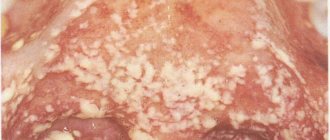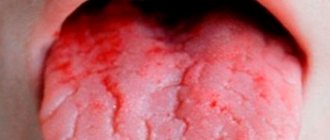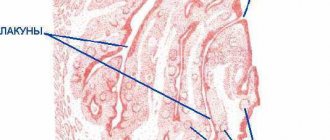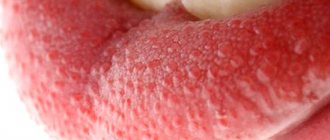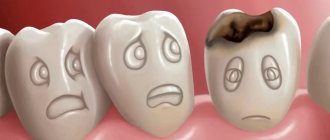Causes of glossitis
Glossitis can be an independent disease caused by bacteria, or a sign of a certain systemic pathology. Microtraumas and viruses usually lead to local damage to the tongue. For example, herpes very often not only affects the mucous membrane of the oral cavity, but also causes the occurrence of stomatitis and glossitis.
Inflammation of the tissues of the tongue can be a consequence of a burn to the mouth or frequent consumption of too hot drinks. Open gates for infection that causes glossitis are mechanical injuries to the oral cavity and tongue. Provoking factors also include:
- smoking, alcohol abuse;
- eating spicy foods;
- using a mouth freshener;
- frequent use of mouth rinses;
- poisoning with salts of heavy metals;
- injury to the tongue by destroyed sharp teeth;
- frequent exposure of the skin of the tongue to chemical irritants and electric current.
Causes of chronic glossitis:
- decreased immunity;
- dysbacteriosis;
- conditions that cause autoantibodies to be produced.
Causes of glossitis in children
Glossitis occurs in children for various reasons. Most often it is provoked by the child constantly biting his tongue. An incorrectly selected brace system can also lead to problems. Desquamative glossitis in young patients is a consequence of helminthic infestations, atopic dermatitis, and blood diseases. In this case, there are usually no difficulties when chewing and swallowing food.
Candidal glossitis in children develops against the background of diabetes mellitus and long-term use of antibiotics.
Membranoprotective therapy for the allergic form of desquamative glossitis
K. G. Karakov Doctor of Medical Sciences, Professor, Head of the Department of Therapeutic Dentistry of St. State Medical Academy
T. N. Vlasova Associate Professor, Department of Therapeutic Dentistry, St. State Medical Academy
A. V. Oganyan Candidate of Medical Sciences, Assistant of the Department of Therapeutic Dentistry of St. State Medical Academy
O. V. Polyakova Clinical Resident, Department of Therapeutic Dentistry, St. State Medical Academy
Desquamative glossitis is a disease of the mucous membrane of the tongue, leading to the formation of areas of desquamation (flaking, peeling) of the epithelium on its surface.
Desquamation areas have different shapes and are located both on the back of the tongue and on its lateral surfaces (Fig. 1-4).
Rice. 1
Rice. 2
Rice. 3
Rice. 4
The disease occurs quite often, its occurrence does not fundamentally depend on the gender and age of a person.
Currently, there are no clearly defined causes for the development of desquamative glossitis. It is known that the development of the disease is based on a malnutrition of the tissues of the mucous membrane of the tongue, as a result of which they desquamate. Difficulties lie in determining the reasons for the violation of trophic tissue of the tongue.
It has been determined with a high degree of confidence that the causative factors for the appearance of desquamative glossitis are diseases of the gastrointestinal tract, pathology of the nervous, hematopoietic, cardiovascular and endocrine systems.
The trigger for the development of desquamative glossitis may be an allergic predisposition, hypovitaminosis, or connective tissue diseases. Desquamative glossitis often accompanies candidiasis (Fig. 5).
Rice. 5
Clinically, superficial, hyperplastic and lichenoid forms of desquamative glossitis are distinguished.
The superficial form is characterized by the appearance of well-demarcated red stripes and spots on the dorsal surface and edges of the tongue. The spots have the appearance of raw meat and are surrounded by intact mucous membrane of normal color. With diffuse desquamation of the epithelium of the tongue, its surface becomes smooth and shiny (“polished tongue”).
This area stands out against the surrounding slightly raised, non-desquamated zone of opacified epithelium. The affected area quickly spreads along the periphery, but retains smooth, rounded boundaries. The intensity of desquamation gradually decreases. Subjectively, itching and burning are noted. Patients complain of an unusual appearance of the tongue.
The hyperplastic form of desquamative glossitis is characterized by focal thickening of the filiform papillae of the tongue, the presence of white, yellow, gray or dark plaque in the affected area, accompanied by a sensation of a foreign body.
The lichenoid form of desquamative glossitis is characterized by the appearance of areas of desquamation of the epithelium of the tongue of various shapes and sizes due to the redistribution of filiform papillae and their grouping surrounded by exposed areas. In the desquamation zone, the fungiform papillae are enlarged. The pattern of changes in the surface of the tongue is not permanent; foci of desquamation can move along the surface of the tongue.
Shumsky A.V., Burda A.G. identify the following forms of desquamative glossitis:
- dysbiotic (microbial) is characterized by the presence in fingerprint smears of pathogenic (St. aureus, β-hemolytic Str. group A) and conditionally pathogenic (staphylococci, clostridia, corynebacteria, etc.) flora;
- candidiasis is characterized by a predominance of blast forms of fungi of the genus Candida with oval and round blastospores, as well as a large number of young and mature forms of pseudomycelium;
- neurogenic (increased norepinephrine concentration to 2.37 ± 0.64 when the norm is 0.35 ± 0.12 ng/ml, ρ ‹ 0.05);
- allergic (eosinophilia, histamine content 0.94 ± 0.08 ng/ml, normal 0.40 ± 0.08 ng/ml).
We are most interested in the allergic form of desquamative glossitis.
The purpose of our study was to study the membrane-protective properties of modern immunocorrective and antihistamine drugs in the treatment of the allergic form of desquamative glossitis.
We examined and treated 7 people with an allergic form of desquamative glossitis aged from 25 to 60 years. All examined were divided into 2 groups: main and control. Main group: 4 people, two men and two women. Control group: 3 people, two men and one woman. The duration of the disease varied from several weeks to 2-3 years.
The clinical examination included the identification of complaints, study of life history and disease, visual examination of the oral cavity and tongue, palpation of the tongue and regional lymph nodes, microbiological examination to assess the contamination of the oral mucosa and dorsum of the tongue with Candida fungi and other microorganisms.
The examination was carried out by dentists together with allergists and gastroenterologists. All examined patients had a history of allergic status and pathology of the gastrointestinal tract.
When examining the oral cavity of patients with an allergic form of glossitis, the mucous membrane was pale and moderately moist. There were tooth marks on the lateral surfaces of the tongue, which indicated interstitial edema. Microscopy of the smear-imprint was practically no different from the microscopic picture in healthy individuals.
Treatment regimens
Patients of the main group received standard therapy:
Local:
- sanitation of the oral cavity;
- antiseptic rinses with chlorhexidine solution;
- applications to the lesions of keratoplasty preparations (solcoseryl jelly, rosehip oil, vitamin A).
General treatment included elimination of the allergenic factor (if possible), vitamin therapy, the use of an antihistamine (Diazolin), 1 tablet 2 times a day for two weeks, an immunocorrective drug (Imudon), 2 tablets 6 times a day for within two weeks.
Patients in the control group received standard therapy using the latest generation of desensitizing drugs (Tinset, 1 tablet 2 times a day for two weeks) and immunocorrective drugs (Likopid, 2 tablets 2 times a day sublingually for two weeks).
During the study, we received a stable remission - a small number of complaints, a decrease in lesions in all those examined. But in the control group, the remission phase began after the 6th visit, and in the main group - by the end of the second week.
The study of the desquamative form of glossitis against the background of an allergic status and the use of modern drugs allowed us to achieve more stable remission in the control group compared to the main group, and therefore we recommend the use of this regimen in practical healthcare.
- Banchenko G.V., Maksimovsky Yu.M., Grinin V.M. Language is the “mirror” of the body: Clinical guide for doctors. - M., 2000. - 407 p.
- Banchenko G.V. Combined lesions of the oral mucosa and internal organs. - M.: Medicine, 1979.
- Burda A.G. Pathogenetic rationale for complex treatment of desquamative glossitis: Abstract of thesis. dis. Ph.D. honey. Sci. - Samara, 2006.
- Danilevsky N. F. et al. Oral diseases. - M., 2001. - 271 p.
- Rybakov A. I., Banchenko G. V. Diseases of the oral mucosa. - M.: Medicine, 1971.
- Yamashev I. G., Solovyov M. M. Linguology as a scientific direction // Kazan. Vestn. dentist - 1996, No. 2. - P. 106-108.
Symptoms of glossitis
Glossitis is manifested by the following general symptoms:
- sensation of a foreign body in the mouth;
- burning tongue;
- discoloration of the skin of the tongue to bright red or burgundy;
- swelling of the tongue;
- increased salivation;
- dullness or complete loss of taste sensations (perversion of taste is possible);
- difficulty in swallowing;
- slurred speech, severe pain during conversation.
If treatment for glossitis is not carried out or is illiterate, the disease becomes chronic. Then dense, persistent swelling of the tongue occurs and its structure changes. In advanced forms, growths may form. The onset of an abscess is indicated by an uneven increase in size of the organ. Then the pain syndrome becomes pronounced.
If glossitis is complicated by phlegmon, purulent discharge appears on the surface of the tongue, and the process of chewing and swallowing food is disrupted. Attacks of suffocation may occur and speech becomes difficult. The body temperature rises, the lymph nodes become enlarged, and weakness increases.
Signs of glossitis caused by bacterial and viral microflora
Glossitis of the tongue, which is caused by pathogenic microflora, manifests itself with symptoms:
- local increase in temperature;
- soreness;
- edema;
- hyperemia.
If the disease is provoked by viruses, it may be characterized by vesicles, after opening which small erosions remain on the mucous membrane. In this case, the taste organ becomes too dense or, conversely, excessively loose, and hyperplastic changes are observed.
Candidal glossitis looks in the photo as a white coating on the tongue.
Symptoms of different types of glossitis
Desquamative glossitis, which is also called “geographical tongue,” usually develops against the background of gastrointestinal diseases. When examining a patient, the doctor sees a tongue cut with grooves and lines, which may resemble the outlines of the continents. The formation of the disease is promoted by:
- blood diseases;
- metabolic disorders;
- parasites.
Bright red spots with desquamative glossitis are located on the front surface and sides of the tongue. In this case, the patient complains of moderate pain and burning.
Deep glossitis is always localized at the “bottom” of the oral cavity. Inflammation can spread to the neck and chin area. Untimely treatment of this type of pathology leads to an abscess.
Diamond-shaped or median glossitis is manifested by thickening of the epithelium and the formation of diamond-shaped areas in the basal region of the tongue. Their color can be bright red or bluish. The form is prone to chronicity and relapse. Very rarely, rhomboid glossitis can be characterized by other signs. Thus, the diamond-shaped areas may become smooth and atrophy (flat form) or dense, bumpy growths may form on the surface of the tongue (warty form of rhomboid glossitis).
Folded glossitis is a congenital anomaly. These are folds on the back of the tongue. The deepest of them runs longitudinally along the midline of the taste organ. Since the disease does not cause discomfort, no special treatment is carried out (only for aesthetic purposes).
The main symptom of villous glossitis is the proliferation of filiform papillae, which subsequently become keratinized and look like small villi. The problem most often occurs with constant trauma to the tongue or with candidiasis.
Gunter's glossitis indicates the development of folate deficiency or B12 deficiency anemia. The tongue becomes very smooth and acquires a bright crimson color. Taste buds atrophy.
Interstitial glossitis (precancerous form) may indicate infection with syphilis. Part of the muscle tissue is replaced by connective tissue. The tongue looks like a quilt. Some of its parts are elevated, the grooves of connective tissue strongly tighten the edges. If treatment is not started, the muscle tissue completely degenerates into connective tissue.
If you notice similar symptoms, consult a doctor immediately. It is easier to prevent a disease than to deal with the consequences.
Changes in appearance depending on the disease
One of the common types is “geographical tongue,” in which its upper surface resembles a map with the borders of countries and continents. This is the most common form of glossitis, which does not manifest itself in any way and does not require medical intervention unless complications arise (numbness, burning). This form occurs in waves, provoked by rough or spicy food, and hormonal cyclic changes. But the loss of the pattern of the papillae may indicate the presence of hypo- or hyperacid gastritis (that is, with increased or decreased acidity of gastric secretions) - such symptoms are typical for patients with gastroesophageal reflux, when hydrochloric acid and bile are thrown from the stomach into the oral cavity.
"Geographical language"
The second most common type of glossitis is a folded tongue. This is an independent type of glossitis. In this case, the back of the tongue seems to be riddled with deep cracks and it feels like there are folds in it. This form of glossitis sometimes accompanies neurological diseases (for example, Melkerson-Rosenthal syndrome) and is present in people with acromegaly (hormone-active pituitary tumor).
"Folded tongue"
Also characteristic are manifestations of various anemias, which are reflected in the appearance of the organ: iron deficiency anemia can manifest itself as a burning sensation on the tip of the tongue, the appearance of cracks on it and an erased pattern of taste buds. Pernicious anemia (B12 deficiency), in which the tongue has a “varnished” appearance with a smooth, swollen surface, sometimes quite painful, with burning symptoms, is the main cause of Gunther-Miller glossitis.
"Lacquered Tongue"
A large group of pathological conditions of this organ are ENT-associated symptoms associated with chronic tonsillitis - here the symptoms are non-specific, ranging from a dirty coating on the tongue to manifestations of diphtheria with white masses that are difficult to remove.
They also distinguish the formation of ulcers on the tongue - aphthous glossitis, which, as a rule, has a viral cause and goes away on its own. This is a recurrent disease, with more frequent episodes it is necessary to exclude pathology of the immune system.
When visiting a doctor, you will often notice pronounced teeth marks on the side of the tongue - a sign of long-term swelling. This occurs in patients with enterocolitis, kidney disease and cardiovascular diseases. The reason for this condition is water retention in the body.
Imprints from teeth on the lateral surface of the tongue
In the presence of abundant white plaque, accompanied by pronounced redness of the oral mucosa, one should suspect a fungal infection, often of a candidal nature. In this case, HIV must be excluded. Also with HIV, “hairy leukoplakia” occurs, when the tongue appears to have white hairs on the side surface, similar to flames - this condition is specific to HIV.
"White Hairy Tongue"
It is worth noting the existence of a “black hairy tongue”, which is a symptom of gastrointestinal disorders, less commonly a fungus.
"Black Hairy Tongue"
As you can see, our organ of taste reflects deep processes in the body, and it is difficult to single out one specialist responsible for its treatment. It is worth involving doctors of different spectrum in therapy, conducting studies based on data from smears and blood tests. But what general recommendations can we, as doctors, give to patients?
Diagnosis of glossitis
Pronounced symptoms allow dentists and therapists (it is these doctors who treat glossitis) to judge the presence of one form or another of the disease. To assess the depth and nature of the lesion, as well as to diagnose the disease that provoked the development of glossitis, different methods are used:
- bacteriological;
- cytological;
- biochemical;
- histological;
- serological.
All these diagnostic methods are available in any modern dental clinic
. To exclude the presence of syphilis, microscopy of the scraping is performed for Treponema pallidum, and an anticardiolipin test (allows us to detect antibodies to the cardiolipin antigen present in the blood of patients with syphilis). If it is necessary to determine the causative agent of glossitis, the following is carried out:
- PCR diagnostics (detection of the pathogen by its DNA);
- Enzyme-linked immunosorbent assay (ELISA). For analysis, blood is taken from a vein. The study is aimed at identifying specific antibodies produced by the patient’s body against the pathogen.
What is glossitis?
What do we know about the tongue as an organ? We know that it is located in the mouth, which helps us articulate and pronounce words correctly, helps us mix food, feel all the diversity of existing tastes, that they can be shown indignation, and in some African countries, a demonstration of it can be used to declare war.
Such a significant number of different physiological and social functions may one day be compromised. And the name of this threat is glossitis.
Despite the absolutely clear location of this organ, there are big questions about which doctor deals with its problems: a dentist, gastroenterologist, maxillofacial surgeon or otolaryngologist. This is not an easy question, and sometimes you can endlessly go from one specialist to another. But let's finally understand this intriguing matter.
How and with what to treat glossitis of the tongue in adults and children
Treatment of tongue glossitis requires elimination of the diseases that led to its appearance. This refers to anemia, gastrointestinal diseases, syphilis, etc. To minimize pain, you need to rinse your mouth with Furacilin, a solution of Chlorhexidine (0.05%) or potassium permanganate, and avoid eating rough food. In case of severe pain, local applications with anesthetics can be made:
- Trimecaine solution (2%);
- Lidocaine solution;
- Pyromecaine solution.
If the tongue is dry, it should be lubricated with a mixture of glycerin and Anestezin.
For a speedy recovery, the skin of the tongue must be cleaned of plaque using a cotton swab soaked in proteolytic enzymes (Chymotrypsin, Trypsin). If there are painful ulcers, these drugs for the treatment of tongue glossitis can be replaced with applications with Iruksol. After the hygiene procedure, it is important to treat the cleaned lesions with antiseptics. This helps prevent secondary infection and also prevents the development of serious complications.
To speed up regeneration processes, gel and jelly-like medicines with solcoseryl, as well as preparations containing vitamin A, can be used. The mixture formed by rosehip oil and vitamin A heals the affected skin well and relieves pain.
If excessive thickening of the stratum corneum of the epidermis (hyperkeratosis) is observed, surgical intervention is ordered. Antifungal, antibacterial and anti-inflammatory drugs are selected taking into account the severity of the disease and the dominant symptoms.
All patients with glossitis can take immunomodulators. Hormones are used extremely rarely - only for difficulty breathing. To avoid atrophy of taste organ cells, Hydrocortisone and Prednisolone ointments are prescribed in short courses.
How to treat tongue glossitis at home
Treatment of tongue glossitis at home can be carried out using traditional medicine recipes:
- decoction of chamomile flowers. 1 tbsp. pour a glass of boiling water over the flowers. Infuse, strain. Rinse your mouth after every meal;
- bedstraw decoction. 1 tbsp. pour a glass of boiling water. Leave for 30 minutes. Take 50 ml orally after meals and rinse the mouth 3-4 times a day. Similarly, you can use decoctions of sage and basil;
- soda solution. Add 2-3 drops of iodine and a teaspoon of baking soda to a glass of warm water. Rinse your mouth 3 times a day;
- natural honey Slowly dissolve a spoonful of honey;
- propolis. Lubricate the areas of inflammation 5 times a day. Instead of propolis, you can use raw carrot/potato juice or rosehip oil;
- tea tree oil. Dilute in equal proportions with olive, sunflower or sea buckthorn oil. Treat glossitis lesions 5 times a day or keep it in your mouth for several minutes.
Causes
One hundred percent causes of this disease have not been identified. And first you need to find out what type of disease we are talking about. If this is the primary type, then the factors are usually external. If secondary - internal, associated with pathologies and diseases of internal organs.
Given the diversity of situations, there are many potential causes of desquamative glossitis, for example:
- tongue injuries due to burns, dentures, teething, etc.;
- chronic diseases of the gastrointestinal tract, gall and liver;
- violation of vitamin and mineral metabolism. For example, when the body lacks vitamins B3, B6 or B1, folic acid, iron, etc.;
- diseases of the hematopoietic system;
- endocrine changes, including during pregnancy;
- autoimmune diseases: rheumatism, lupus, systemic scleroderma;
- chronic dermatoses - the same as psoriasis;
- acute infections: from influenza to typhoid fever;
- helminthic infestations;
- drug intoxication. It can occur due to improper or uncontrolled use of antibiotics and other medications;
- heredity.
It is obvious that with such a variety of causes of desquamative glossitis, effective treatment begins with a thorough diagnosis. First, the doctor needs to rule out a huge number of diseases - and only after that it will become clear how to act.
Treatment of desquamative glossitis
To understand how to treat desquamative glossitis, it is necessary to determine its cause. To do this, a diagnosis is carried out: first by a dentist, and then by a therapist and, if necessary, specialized specialists. Patients take a swab from the oral cavity for microflora, which can be used to determine the nature of the lesion (viral, fungal, bacterial). You may also need ultrasound diagnostics, a general or detailed blood test.
As a rule, desquamative glossitis goes away after the disease that caused it is eliminated. At the same time, local therapy is prescribed: antiseptic rinses and ointments, pain relief. The doctor may prescribe antibacterial or antifungal drugs, and if there is noticeable discomfort, give an injection of novocaine.
Sanitation of the oral cavity, including professional hygiene, is mandatory during therapy.
Desquamative glossitis does not always require special treatment, since it does not pose a serious threat to health, and its symptoms go away on their own over time (this is especially typical for children). But the problem cannot be left to chance, because there is a risk of developing chronic desquamative glossitis.
